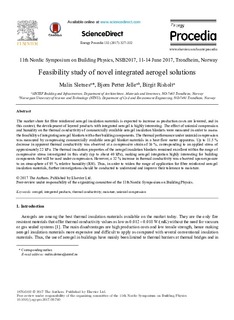| dc.contributor.author | Sletnes, Malin | |
| dc.contributor.author | Jelle, Bjørn Petter | |
| dc.contributor.author | Risholt, Birgit Dagrun | |
| dc.date.accessioned | 2017-10-26T07:09:18Z | |
| dc.date.available | 2017-10-26T07:09:18Z | |
| dc.date.created | 2017-10-20T09:39:16Z | |
| dc.date.issued | 2017 | |
| dc.identifier.citation | Energy Procedia. 2017, 132 327-332. | nb_NO |
| dc.identifier.issn | 1876-6102 | |
| dc.identifier.uri | http://hdl.handle.net/11250/2462234 | |
| dc.description.abstract | The market share for fibre reinforced aerogel insulation materials is expected to increase as production costs are lowered, and in this context, the development of layered products with integrated aerogel is highly interesting. The effect of uniaxial compression and humidity on the thermal conductivity of commercially available aerogel insulation blankets were measured in order to assess the feasibility of integrating aerogel blankets with other building components. The thermal performance under uniaxial compression was measured by compressing commercially available aerogel blanket materials in a heat flow meter apparatus. Up to 11.5 % decrease in apparent thermal conductivity was observed at a compressive strain of 16 %, corresponding to an applied stress of approximately 22 kPa. The thermal insulation properties of the aerogel insulation blankets remained excellent within the range of compressive stress investigated in this study (up to about 40 kPa), making aerogel integration highly interesting for building components that will be used under compression. However, a 32 % increase in thermal conductivity was observed upon exposure to an atmosphere of 95 % relative humidity (RH). Thus, in order to widen the range of application for fibre reinforced aerogel insulation materials, further investigations should be conducted to understand and improve their tolerance to moisture | nb_NO |
| dc.description.sponsorship | Acknowledgements. This work has been supported by the Research Council of Norway and several partners through “The Research Centre on Zero Emission Buildings” (ZEB). | nb_NO |
| dc.language.iso | eng | nb_NO |
| dc.publisher | Elsevier Ltd. | nb_NO |
| dc.rights | Attribution-NonCommercial-NoDerivatives 4.0 Internasjonal | * |
| dc.rights.uri | http://creativecommons.org/licenses/by-nc-nd/4.0/deed.no | * |
| dc.subject | Aerogel | nb_NO |
| dc.subject | Integrated products | nb_NO |
| dc.subject | Thermal conductivity | nb_NO |
| dc.subject | Moisture | nb_NO |
| dc.subject | Uniaxial compression | nb_NO |
| dc.title | Feasibility Study of Novel Integrated Aerogel Solutions | nb_NO |
| dc.type | Journal article | nb_NO |
| dc.type | Peer reviewed | nb_NO |
| dc.description.version | publishedVersion | nb_NO |
| dc.rights.holder | © The Authors | nb_NO |
| dc.subject.nsi | VDP::Technology: 500 | nb_NO |
| dc.source.pagenumber | 327-332 | nb_NO |
| dc.source.volume | 132 | nb_NO |
| dc.source.journal | Energy Procedia | nb_NO |
| dc.identifier.cristin | 1506160 | |
| dc.relation.project | Norges forskningsråd: 193830 | nb_NO |
| cristin.unitcode | 7401,30,0,0 | |
| cristin.unitname | SINTEF Byggforsk | |
| cristin.ispublished | true | |
| cristin.fulltext | original | |
| cristin.qualitycode | 1 | |

